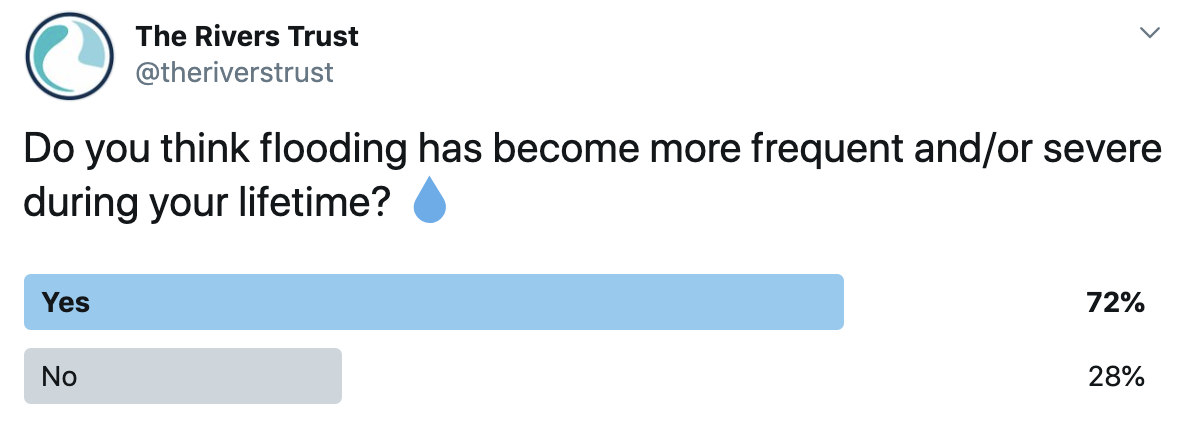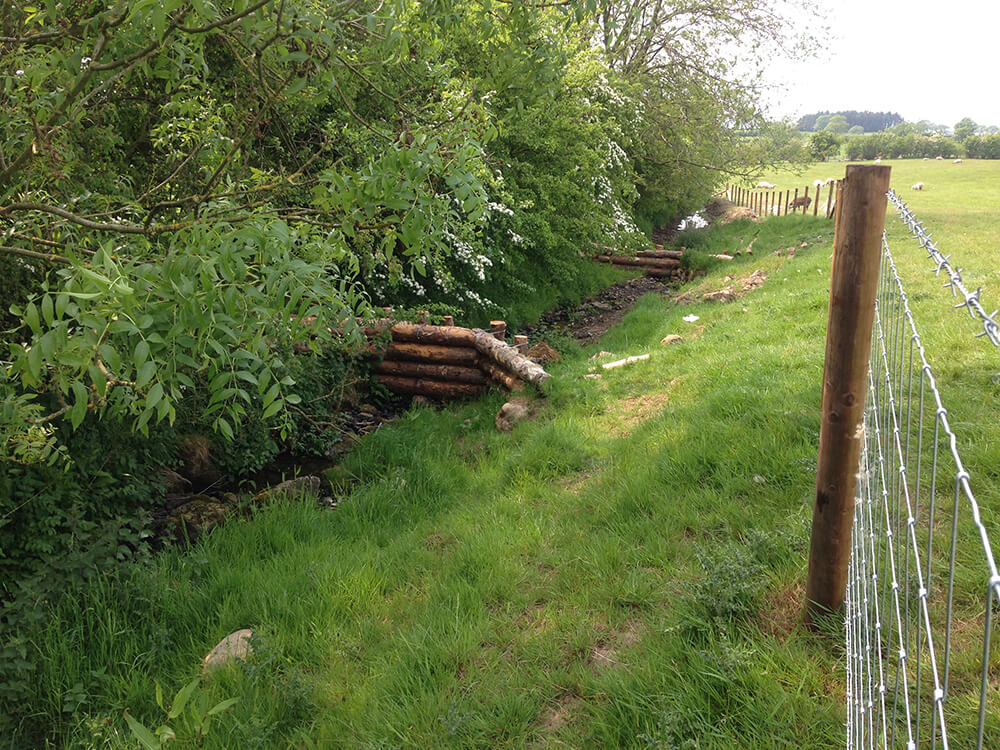Is flooding worse than before?
72% of Twitter respondents thought flooding had gotten worse in their lifetime!
04/11/19
We recently asked our Twitter followers whether they thought that flooding had become more frequent and/or severe during their lifetimes. A resounding 72% thought that it had.

In their natural state, river catchments are capable of storing water throughout the landscape. The natural features of our rivers also slow the flow of water downstream, reducing the chance of flash floods. Many modern rivers have lost this ability, making them vulnerable to heavy rain—but why is that?
There are a huge number of factors which have contributed to worsening floods, but by understanding them we can attempt to remedy them. Today, we're going to discuss some of the worst offenders when it comes to flooding.

Climate Change
The first factor contributing to more frequent or severe flooding is rain itself. Climate change can intensify rainfall in two ways. Firstly, as the atmosphere gets warmer, it becomes capable of holding a greater volume of water. This means that when the rain does fall, the quantity is far greater. Secondly, rising temperatures cause more water to evaporate from the ocean, contributing towards extreme rain events.
Many landscapes can tolerate slow falling rain, but when rain falls hard and fast the land becomes unable to drain properly, and flooding occurs as a result.
Habitat destruction
Many of our green spaces have been removed to make way for developments. Soil and grass are replaced by impermeable concrete, preventing water from draining away. Unable to sink into the earth, the water accumulates on the surface, leading to flooding.
Globally, wetland extent is estimated to have declined by more than 50% since 1900. This is likely to have had a devastating impact on flooding. Wetlands act like sponges, soaking up water during periods of high rain, then releasing it slowly over time. They provide a huge amount of water storage, and losing so many in such a short space of time has had devastating effects.
Like wetlands, forested areas can protect against flooding in a number of ways. The presence of a leafy canopy slows rain before reaching the ground, allowing more time for the water to drain away. The soil structure in forests lends itself to storing and slowly releasing water, and water consumption by the trees themselves can also help to reduce flooding. Unfortunately, we are losing one football pitch-worth of forest every second - meaning that they can no longer help to mitigate flood risk.
Agriculture
The intensification of agriculture has also contributed to worsening floods. Through a combination of heavy machinery and livestock, soil can become compacted. This removes the natural drainage channels which exist in the earth, causing water to sit on the surface rather than draining away.
In addition, the elimination of ‘buffer zones’—strips of land next to the river, kept in permanent vegetation—has also had an impact of flooding. Without these natural barriers, when it rains, all of the rainwater which runs off of the fields can enter the river very quickly, contributing to flash floods.
Housing developments
Approximately one in ten new homes are constructed in areas where there is a significant risk of flooding. Naturally, the chance of flooding is already high in these areas - and when permeable materials are replaced with concrete to allow the development of new homes, the existing problem is exacerbated. As a result, we see more instances of people's homes flooding.
Drought
Bizarrely, severe periods of drought can also increase the risk of flooding! Without rain, the earth becomes incredibly dry and compacted. This means that when the rain finally arrives, it struggles to sink into the soil and instead accumulates on the surface.
What can I do to help?

Volunteering with our local Trusts can be a great way to tackle flooding in your area. Many of our Trusts carry out work known as Natural Flood Management (NFM), which is essentially where natural materials and processes are harnessed in order to slow the flow and store more water. Sometimes, local Trusts will need volunteers to help implement new NFM solutions—whether that's through helping plant trees, or installing leaky dams on the watercourse (see the photo above).
One of @RibbleTrust leaky dams in action during #StormCiara. Note the bonus of #sediment trapping in action as flood waters recede. Fine sediment accumulation in rivers can reduce productivity for fish and insects and lock in river beds reducing healthy sediment transport. pic.twitter.com/VCnCKa11UN
— Mike Forty (@Mike_Forty) February 13, 2020
The video above shows Rivers Trust's leaky dam in action during the recent Storm Ciara. By temporarily holding back the water, the leaky dam slows the flow of water downstream, reducing the chance of flash floods. Note the bonus of sediment trapping in action as flood waters recede. Fine sediment accumulation in rivers can reduce productivity for fish and insects and lock in river beds, reducing healthy sediment transport. Thanks to Mike Forty for the video and information.
So, what next? Well...
- Find out what our Chief Exec, Mark Lloyd, wrote about the recent floods.
- Donate: you could help us to support our local Trusts in reducing flood risk locally
- Volunteer: you could get stuck in, helping to tackle flooding in your area
- Fundraise: funds you raise could help to support the delivery of NFM projects in at-risk areas
This post is supported by WaterCo-Governance (WaterCoG) project under the Interreg North Sea Region VB programme, funded by the European Regional Development Fund.
